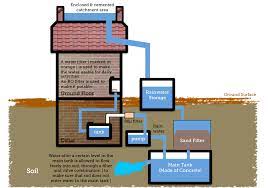Australian homeowners are increasingly interested in rainwater harvesting as an environmentally-friendly and cost-effective way to supplement their water supply. One of the most common ways to collect rainwater is through a roof-mounted rainwater tank. However, before you install a roof-mounted rainwater tank on your Australian home, there are some important considerations to keep in mind. In this article, we’ll go over some tips on how to determine if you can install a roof-mounted rainwater tank on your Australian home.
What Is a Roof-Mounted Rainwater Tank?
A roof-mounted rainwater tank is a large storage container, typically made of galvanized steel or polyethylene, that is placed on the rooftop of your home. The tank collects runoff from rain and other precipitation (including snow) and stores it for later use. When properly installed, these tanks can provide an environmentally friendly and cost-effective way to collect and use rainwater for your garden, washing machine, and other home uses.
Is My Home Suitable for a Roof-Mounted Rainwater Tank?
 The first step in determining if you can install a roof-mounted rainwater tank on your Australian home is to assess the structural integrity of your roof. You’ll need to ensure that the additional weight from the tank won’t cause any damage or weakening of your existing roof structure. If you have an old roof, installing a rainwater tank on it may not be feasible.
The first step in determining if you can install a roof-mounted rainwater tank on your Australian home is to assess the structural integrity of your roof. You’ll need to ensure that the additional weight from the tank won’t cause any damage or weakening of your existing roof structure. If you have an old roof, installing a rainwater tank on it may not be feasible.
After determining the suitability of your home, there’re a few factors you should consider. They include:
1. Check Your Local Regulations
The first thing you need to do before installing a roof-mounted rainwater tank is to check your local regulations. Each state and territory in Australia has different laws and regulations regarding rainwater harvesting and the installation of rainwater tanks. Some may require permits or have restrictions on the size, location, and type of tank you can install. You can check with your local council or government agency to find out the specific requirements in your area.
Regulations differ between states, so make sure to check with your local government before you proceed. The best way to find out is to contact your local council and ask what is required.
2. Check Your Roof’s Structure
It’s important to ensure that your roof’s structure can support the weight of a roof-mounted rainwater tank. Rainwater tanks can weigh several tonnes when they are full, so it’s crucial to have a strong and sturdy roof. If you’re not sure, consult a structural engineer or a licensed builder to assess your roof and determine if it can support the weight of a rainwater tank.
3. Check Your Roof’s Material
The material of your roof can also affect whether or not you can install a roof-mounted rainwater tank. Metal roofs, such as Colorbond or Zincalume, are ideal for rainwater harvesting because they are durable, long-lasting, and have a smooth surface that allows rainwater to flow into the gutters easily. However, tiled roofs can also be used for rainwater harvesting, but it’s important to ensure that the tiles are in good condition and that there are no cracks or damage that could lead to leaks.
4. Check Your Gutters
Your gutters are an essential part of your rainwater harvesting system, as they collect and direct rainwater into the tank. Make sure that your gutters are clean and free of debris before installing a roof-mounted rainwater tank. You may also need to install additional guttering or downpipes to ensure that all the rainwater is directed towards the tank.
5. Choose the Right Size
The size of your roof-mounted rainwater tank will depend on a variety of factors, including the size of your roof, your water needs, and your budget. It’s best to consult with a professional to determine the appropriate size for your needs.
Conclusion
Installing a roof-mounted rainwater tank on your Australian home can be a great way to save money on your water bill and reduce your environmental impact. However, it’s important to check your local regulations, ensure that your roof’s structure and material can support a rainwater tank, check your gutters, and choose the right size for your needs. By following these tips, you can enjoy the many benefits of rainwater harvesting while ensuring that your installation is safe and compliant with local regulations.



